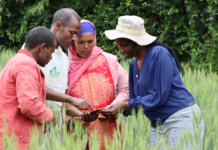A study by Boston Consulting Group that assesses the use of digital technology in agriculture in fourteen geographies across sub-Saharan Africa and South Asia, identifies three insights that many governments and private- and social-sector players fail to fully appreciate, and provides ways forward for these stakeholders.
The use of digital technologies in agriculture has the potential to transform Africa’s food systems to deliver better livelihoods for farmers, high quality and more consistent ingredients for processors, and healthy and sustainable diets for consumers. Yet few digital ag (agriculture) solutions have reached scale.
In sub-Saharan Africa, only 15 digital ag solutions exceed the 1 million registered users mark, and in many cases only 15% to 30% of registered users are active. This showcases the unrealised promise of digital agriculture in Africa and the need to explore various mechanisms that will enable the new frontier for food systems.
To understand why digital agriculture has not yet lived up to its potential and how countries might accelerate development of the sector, Boston Consulting Group (BCG) conducted an in-depth assessment of activity. It shares key insights in its report The Digital Agriculture Revolution Will Take More Than Innovation on what may be holding digital agriculture back.
“We undertook an in-depth study of activity in fourteen geographies spanning sub-Saharan Africa and South Asia,” says Chris Mitchell, Managing Director and Partner at BCG, Nairobi, “we found that despite the many individual success stories in digital agriculture, its impact on smallholder farmer incomes is still limited,” he adds.
In underdeveloped countries, governmental and commercial sources have invested significant energy and money in digital agriculture during the last decade, but despite this, the impact on the lives and livelihoods of the world’s more than 500 million smallholder farmers is not as significant.
BCG’s report shows that agricultural productivity will need more than innovation. Until adequate growth-stage capital and a strong focus on developing robust, scalable business models are in place, meaningful impact will remain out of reach.
Exploring the unrealised promise of digital agriculture
Agriculture forms the backbone of many developing economies and provides income and livelihoods for millions of smallholder farmers. These farmers face multiple problems that severely limit their agricultural productivity and income potential. However, digital agriculture can help them overcome these challenges by increasing their productivity and integration into food value chains.
Expanding access to technology in developing countries is setting the stage for accelerated digital ag innovation. “Digital ag has the potential to transform the sector much like digital tools have done in finance and health care,” says Mitchell.
There are three key factors identified in the report that are holding digital ag back:
- It’s a journey
Digital ag ecosystems evolve along a continuum. Different stages require a different balance of investment in enablers, including digital infrastructure, and digital stack components, including mobile infrastructure, digital identity layers, and digitisation of land records. 75% of scalable interventions operate in just three countries: Kenya, South Africa, and Nigeria – all of which have relatively well-developed digital ecosystems. Enablers and digital stack components typically don’t create immediate impact, but they are critical to the development of high-impact solutions including digital advisories, supply chain solutions, and e-marketplaces.
- Innovation isn’t enough
Digital ag solutions often fail to scale because of limited growth-stage financing and capabilities. Factors contributing to the high level of risk include restrictive regulatory environments, the challenge of integrating millions of smallholder farmers into the market, and the potential negative impact of climate change on the economics of the ag market in the years ahead
As a result, these businesses often need strategic investments, including bridge capital, and expertise in growing complicated business models across multiple geographies simultaneously. Today, relatively few strategic investors and accelerators are on- hand to provide this support and capital, and most of them are international. Such investors often shy away from ventures that carry high levels of risk, such as those present in early to middle-stage digital ag plays in these countries.
- Markets matter
Domestic agriculture markets in many developing countries remain fragmented and inefficient. This can be attributed to factors such as information gaps, price asymmetries, weak systems for aggregating output and quality assurance, and significant logistics and transportation issues.
“Digital ag efforts are not sufficiently focused on addressing the situation, yet solutions can, for example, offer price information services for inputs and outputs, enable demand and supply aggregation, and facilitate e-marketplaces,” he says.
The report also identifies three key stakeholders and the role they can play in advancing digital ag. Governments, private-sector players, development organisations and donors all have parts to play in driving the development of the digital ag ecosystem.
- It is critical for governments to begin by identifying the maturity level of their country’s or region’s digital ag ecosystems. Governments can also play a critical role in digitising data to make it accessible and structured for digital solutions. Making the digital data available to private-sector players will enable them to focus on developing optimal tools and solutions.
- Agribusinesses, Mobile Network Operators (MNOs), and small and medium size enterprises (SMEs) can provide last-mile access to smallholder farmers. MNOs can drive explosive, cost-efficient growth in digital infrastructure, while large agribusinesses can help support the scaling of winning digital ag solutions.
- Development organisations and partners are uniquely positioned to take an ecosystem approach. They can connect the dots between promising solutions and capabilities, capital, and coordination.
“The cross-cutting nature of the digital solutions will continue to improve inter-connectedness among stakeholders in the agricultural value and supply chains,” says Mitchell. “This will boost efficiencies and productivity earnings in the sector while feeding the growing population sustainably and improving livelihoods of African farmers.”
A copy of the report is available here.








